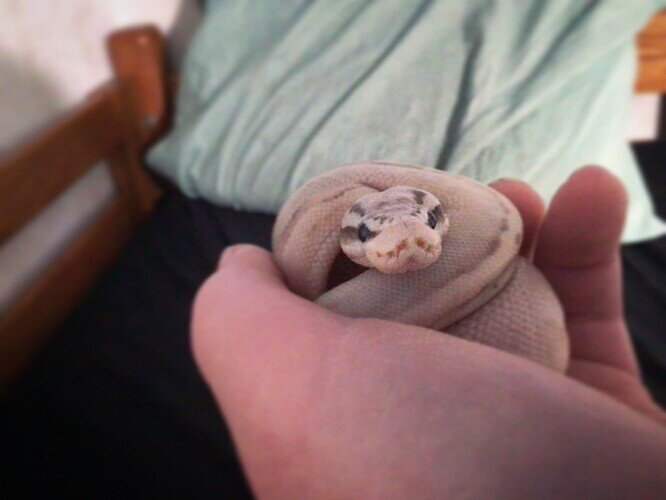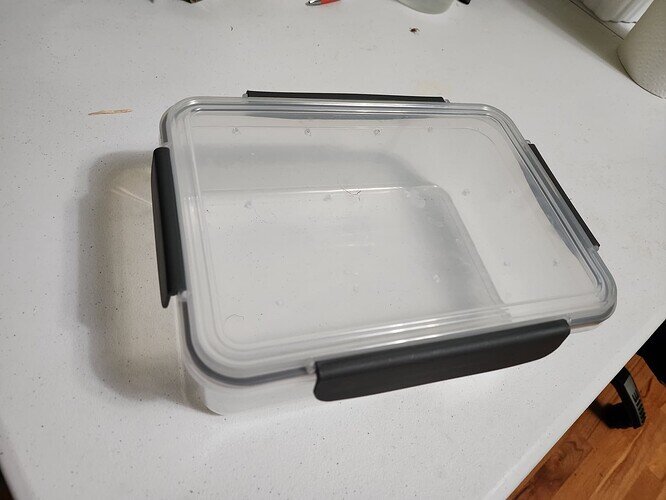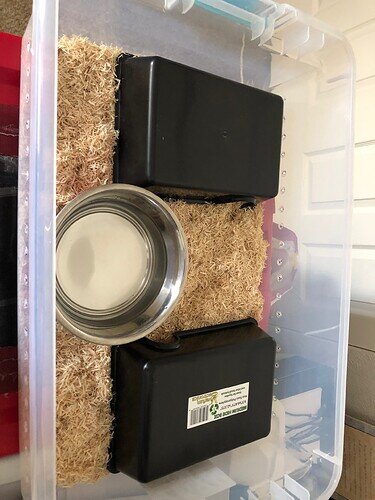The pictured baby boy just won’t eat! We‘ve tried every type of prey and method we can think of! Rats, mice, frozen-thawed, pre killed, live, scented with toad, scented with bird, assist feeding, force feeding even. Should I go to a herp vet? I’m fairly new to keeping, so I thought I’d ask the more experienced. Is there anything I can do?
First things first… Stop holding the baby.
You do not want to be handling a snake until ideally it has eaten at least 3 times in your care so approx. 3 weeks once eating. Also the more you are attempting to feed can be stressing the little one out even more.
Second.
We definitely need more info! How is this snake being cared for? Did you hatch it or buy him? How long have you had him? What kind of home do you have set up? How often and what time of day are you trying to feed?
If you do have him set up in anything larger than a 5-10 gallon sized tank, that may be far too much space. Ball pythons like to feel secure and safe so a sparsely laid out tank with not enough hides is way too scary. It may be easier to start out with a small plastic tub, a thermostat and a heat pad to start with the basics.
Small and secure works best because they are ambush hunters. A small hide that almost barely covers them fully is what they tend to like best.
Personally, I had a VERY small hatchling, 27 grams that refused to eat until last month. That was at 4 months old. I assist fed her once a week and when she finally started showing interest in food scents, what she needed to get started (along with that bit of growth to 38 grams) was discontinued assist feeds and a change of shoebox tub bedding to Aspen instead of paper towels.
These snakes can be very habit forming, so sometimes you need to break the current habit to get them to reconsider.
Hope the little one eats for you soon!
The more info we know maybe the sooner we can pinpoint what’s wrong.
Smallest darkest enclosure possible. Ideally 6qt tub with 2 small hides and a waterbowl between them. That creates plenty small, tight, snug spaces to coil up and feel safe under or wedged between. Minimal exposure to direct light. Light, shadows, motion can put them into defensive postures. No recreational handling until its an established eater. Try mouse hoppers for a meal or two. Offer once every 5 to seven days. Dont constantly change the process. Things with snakes happen slowly, not daily or even weekly. More like monthly or seasonally. Slow down a little. Youve already tried 8 or 9 different feeding techniques for an animal that is young and small enough that it may not even have needed 9 meals. Slow and steady wins the race. Hopefully your little finds its comfort zone and feeds soon.
Have to agree with @armiyana & @nolagregg. No handling. Slow down. I have the same questions, how old, has it eaten before, what is the housing setup (size, temp, humidity, hides and/or non clear enclosure, how often you trying to feed? These questions are important to help narrow down a situation and permanent fix.
Pretty much everything has been said other than he is a very cute little guy! He’s curled up like whipped cream with a pink snout sticking out!
But seriously though, he has been eating before you got him so you definitely don’t have your husbandry on point. And BPs do like it hot with a generous amount of humidity.
You will get the very best advice here to get him started eating again and he will. These people here know what they’re talking about! Don’t despair!
Best of wishes to you and Little Pink Snout! He’s adorable!
Caron 




Thanks for your help, everyone. I bought him on this site. His humidity is 80 percent with an 87 degree temperature. He has 2 hides. I have my snakes on paper towels because one of my snakes somehow got mites, so we want to monitor everything. Ideally, he’ll be eating every 6 days in the evenings, but we’re just trying to get him to eat regularly. He ate for us once before. We’ll downsize him, among everything else you mentioned. He’s 66 grams, if that helps. <3
@kpellman Did you by chance contact the breeder to see how, when, where and what the little guy was eating, what size rack tub he was in, what substrate he was on, etc.? I do that sometimes when I buy a new animal so that I can try to mimic that setup/environment until the new animal has become an established eater. @armiyana @d_y_python @nolagregg
I would follow what @caron posted.
Thank you for sending more information. Sounds like they temp is good, make sure you have a cooler side as well. The humidity is high. Having it at 60 would be ideal, and 50 range would not be bad either. I would take it to 65 up to 70 when Shedding.
You stated it ate once for you, so guessing you have not had it very long, maybe a couple months? Since it was eating, I would hold off on trying again for at least a week. Then, I would try live pinky mouse to make sure the food temp is correct and most start out with live. If no interest, wait another 5 - 7days and try again but get mouse with fur on it. Either time, leave it in for several hours or even over night. This size will not hurt the snake. Yoy can try moving it around in front of it to see if you can get its attention, before you just live it in. Not watching or covering the cage can also help.
Not sure what size cage you are using. But if you can’t copy what the seller had, then I would get a small storage bin with lid that clamps tight, make or find a small hide the same size of your new friend and small water dish. Target sells a 16 cup food bin, put a few holes in the lid and baybe on 2 side. Set 1/3 of it on a heat pad and use paper towels. Leave it in for a week, then try feeding again. Some line very small places and are scared in larger ones. (if you can, cover 1/2 the bin to block more light and give more hiding area.)
Lights, balls do not need lights of any kind. Room light will be enough, and no special lamps are needed.
Please do not handle it until it starts eating on a regular schedule again.
A regular schedule to me would be once a week (7days), at this age. But if it happens to be every other week, then it is also not a bad thing. Some like this schedule as well.
We all know how had this is to do, but it is the best thing for it. NOT handling it until it is settled and eating is something none of us like to do, after all, we did get it handle and not just look at.
Keep us posted on your steps and progress.
@d_y_python as well. So here is a picture of my BP girl Wrenn’s tub set up. It’s a 32 quart Sterilite tub with holes in the sides for ventilation. It’s plain and simple and works for her. In other words, she feeds consistently. I will, however, be upgrading her in the near future because she is almost too large for her tub now. She is about years old and eating f/t medium rats weekly. Sometimes I give her a small rat to switch up sizes. I may not feed her this week because she has just shed, which she has no problem doing in this set up.
This is just an example of what works best for her.
@caron looks real similar to what we used.
I have 12, 33, 52 quart. We used them all the time, until we went to fb racks. Now we use them for spare, hatchling, juveniles. I went with the Ezy Storage because I like how the lids locked tight and all 4 sides (6 locks on the bigger ones.) we only moved to racks because we decided to extend and this was the better option for space. We could get 20 in a rack ver 15 max on shelves, for the same foot space.
We used heat pads with regulators built in on them so we only have to heat the ones being used. We placed them on a shelving unit as we started to get more.
There is nothing I can say bad about this setup. Cheap secured, easy handling and cleaning. And everything thrives in them. Need more humidity or heat, rape up some holes, need less, uncover them.
Yep, we are on the same page. But I am going to check out the Ezy Storage bins. I like the concept of more locks for security……. 



I’m a firm believer that you can keep a snake in a large space so long as it is cluttered enough with plenty of hiding spaces  They aren’t restricted whatsoever in the wild when it comes to space and light.
They aren’t restricted whatsoever in the wild when it comes to space and light.
@shaded1535 you are correct.
When it comes to problem eating or thriving, it is always best to go smaller for a lot of ball pythons. For some reason it helps and they tend to do better. Now, with one that has no issues, or as they get bigger and no problem eating, I say go as big as you want. As long as it is set up as you stated.
When it comes to light, being nocturnal, a daytime or bright light is not needed. Natural room light does the job. As for any uv type or special lighting, it is over kill and unnecessary. They do not need it or get anything from it. It does not hurt to use them, but it is an extra cost and maintenance for something not needed.
I have not seen any negative change in them when moved from a tank or clear bin to a rack system. All 3 types have been used for years and will always be used. Tanks take up the most room, loose more heat and humidity, take up more time.
Bins/storage tubs take up less space, holds heat and humidity better.
Racks take up the least amount of space, helds heat and humidity very well.
The benefits for a rack (witch has no lighting) is more animals in the same footprint, holds heat and humidity better or at least the same as a storage tub, easy access and cleaning. Even with no lights, they still thrive quite well. And with smaller space, tend to eat better.
I will never knock someones setup. If it works for them, then that is all that matters. I do feel that giving information about what others have done, tried, and have is all good. And out of all the information, someone else could benefit from the past experience without going through it themselves.
Yes I agree, provided the snake is eating and thriving. If this is not the case, advice from other experienced keepers helps to determine what adjustments need to be made to insure the snakes eats. I don’t have a rack system myself and I have about 20 reptile pets plus a toad and a frog. I don’t have the space for large set ups so tubs work best for me. Except for my 3 CAs ( the 2 adults do have 4x2x2 Boaphiles and their daughter will need one some day) most of my collection due not require large enclosures as adults. I have had tanks in the past but for me it is so much easier to clean tubs than tanks. However, that only pertains to my personal preference.
Would I like to have magnificent displays for all my collection if I had a room dedicated only to my reptile collection? You had better believe it! However, I have to compromise. But all of my guys are well cared for.
Have a blessed New Year!
Caron
I have one other suggestion and that is to invest in a reptile scale if you don’t already have one. It would be wise to keep a record of his weight since he is not eating for you. @d_y_python I can’t remember off hand what the grams per month is safe for a snake to lose up to a certain point before intervention is necessary?
Also I am assuming you have a reptile vet at your disposal? In lieu of force feeding a prey item, there are other methods and food a reptile vet can use to jump start your little guy. But this is only necessary of course as a last resort. Hopefully the adjustments you need to make that have been suggested here will do the trick. Just be sure to keep a check on his weight…….
Have a blessed and safe new year! 


@caron if it is an established eater you really do not have may options. Force feeding would be for one that has not eaten. Some will say you can force feed at any point in life. Most do not agree, because of stress and regurgitating. For an established non eater:
- Try offering once a week. For a few weeks.
- Try offering every other week. Stick to this until eating.
- Best to offer live and smaller then usual. You may have to go very small to start with. Then a slow increase in size.
- For baby’s, offer something with fur on it.
- Switching to mouse seems to work better, but not a guarantee.
- I have not had a chance to try it early on, but reptile electrolyte soak. I have done it with success on adults off feed for a year. I’m did 30min soaks 2 times a week, Tues & Thur, then fed on Friday. Still have one I am doing this with.
*if a baby non eater that may had a couple meals, force/assistance feedind may be beat option.
I don’t think there is a set weight loss guide. If you can start seeing the spine or a more triangle shape, then there was significant weight loss. One of mine did this, weight from 1026g to 734g. Then I heard of the soak option.
Other very important things,
Change environment, cage size smaller, different substrate, more hides, temp and humidity changes, move to another area keep in a draker place (more covered), do not handle while not eating.
Make sure your temps are on, this is a big factor in not eating. I did everything in this section and items 1&2, before trying the other options.
Non of this is applicable of there is an illness. Any possible illness should be a vet visit. Having it checked to be safe is always a good option.
You will find many other options on prepping food, wash, boil, rub other scents on it. All have been discussed on here before.
Sorry, it got quite lengthy for a short response I was wanting to do. But I could not stop.
Hey, I say the more info the better! As long as it’s goi info.
The reason I mentioned the vet option is because when I worked there, and long since I have been gone, I have seen her administer food via tube, to get some food/nutrients in the belly, when a snake stops eating to kick start the appetite. The “food” was a high quality prescription wet dog food called “Recovery”. However the procedure is stressful for the snake of course.
Now that being said, my vet is not a breeder. Her way is based on a “sick patient” situation. You, as a breeder, offer much more common sense natural solutions, which are far more informative/beneficial, not to mention beneficial to the snake. And yes there is a big difference between “eaten a few times” and “never eaten at all”.
I am glad you brought up the soak idea. Where can I get it? I have a 4 year old CA boa that’s gone off feed for the second winter in a row. Should I try this on him?
This is why I love this forum so much! We learn off each other/share knowledge/ideas without conflict! Well, most of the time! Lol!
But yes, soak info PLEASE! I have just plain ole pedialyte but nothing made specifically for reptiles……



I don’t see it hiring to try it. From waht I heard, it has been used on on and off eaters. I have 1 that if it does go off again, I will be soaking.
Amazon, reptile electrolyte soak.
Follow directions to mix, but I soak for 30min each time. As stated before, I soak on Thursday then Thursday and feed on Friday. But my feeding days at Friday. And I skip a week for soaks and feeding.
Ok thank you!



